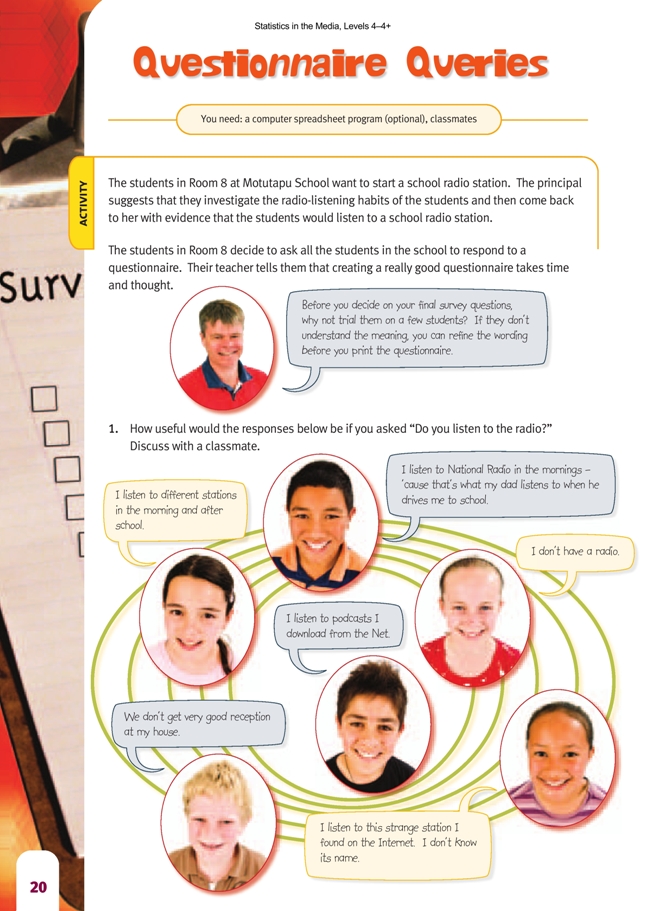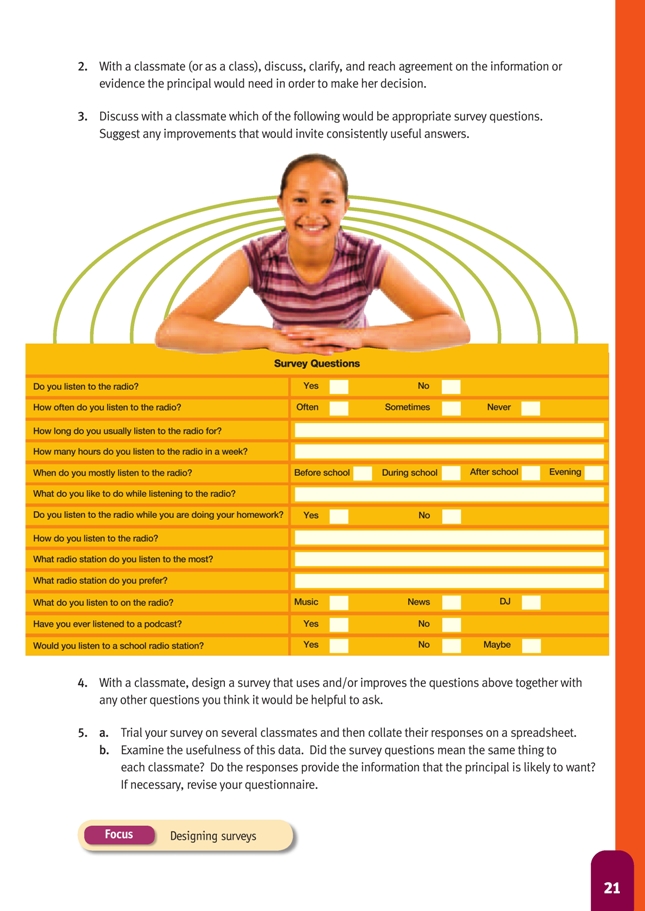This is a level 4 statistics activity from the Figure It Out series.
A PDF of the student activity is included.
Click on the image to enlarge it. Click again to close. Download PDF (1342 KB)
critique a survey
design a survey
This diagram shows the areas of Statistics involved in this activity.
The bottom half of the diagram represents the 5 stages of the PPDAC (Problem, Plan, Data, Analysis, Conclusion) statistics investigation cycle.
Statistical Ideas
Questionnaire Queries involves the following statistical ideas: using the PPDAC cycle, investigative questions, and survey questions, planning an investigation, designing a questionnaire, and doing a pilot study.
FIO, Levels 4 -4+, Statistics in the Media, Questionnaire Queries, pages 20-21
Classmates
Students at this level often fi nd it diffi cult to write survey questions and can fi nish with more responses in the “other” category than in any other. This activity provides an opportunity to discuss ways to avoid this pitfall.
Before the students begin, encourage them to decide on an interpretation of the problem. They need to collectively decide on their answers to questions such as: “What does a school radio station entail?”
“What will be the hours of operation?” “What are the rules of use?” Agreeing on these will make the purpose for this activity more meaningful.
Question 1 demonstrates the need for survey questions to be specifi c and focused in terms of the possible responses required. Ask the students how they could categorise the answers given – they won’t find it easy!
Question 2 asks students to clarify the problem in order to make a plan. It is an excellent opportunity to focus on the “problem” and “plan” parts of the PPDAC cycle.
Problem
The problem or investigative question is basically: “What are the radio-listening habits of students at Motutapu School?”
Plan
Questions to prompt students’ thinking about the planning phase could be:
• What evidence is needed?
• What variables should be collected?
• How will they be measured?
• Why would we want to collect information about gender and age?
• Who should we ask?
• What listening habits should we ask about, weekdays or weekends?
• How will we record the data?
One way to approach question 3 is for the students to trial this questionnaire with a few classmates before deciding which survey questions to keep and which to dismiss or change. They will need to clarify the “measure”. For example, for “How often do you listen to the radio?”, they need to ask themselves: “What does ‘often’ mean?” “What does ‘sometimes’ mean?” One way to fi nd out is to start by asking some
classmates the original open question (“How often do you listen to the radio?”) and use their responses to refi ne the categories and what they mean by them.
For question 4, the students need to understand that questionnaires can be designed to collect either qualitative or quantitative data. These terms may vary in meaning depending on the context. In general terms, qualitative (subjective) data is gleaned from interview questions. The less directed the question, the more qualitative it is. Quantitative (or measurable) data is gleaned from surveys that have been given to a
large number of people. Both types of data have advantages and disadvantages (you may like to discuss these with students). When designing a questionnaire, it may be helpful to interview a smaller number of people in order to generate some likely responses (qualitative data), then use these to create the response categories for a survey that can be given to a large number of people to get quantitative data.
Extension
Use a similar process for a topical issue in your school.
Answers to Activity
1. All the replies give information, but it would be very diffi cult to collate that information meaningfully.
2. Answers will vary depending on interpretation of what having a school radio station would involve. For example, the cost of equipment and extras such as music CDs, the student and teacher time involved, and whether enough students would listen to make it worthwhile.
3. Answers may vary. The questions are not very good ones and could be tightened up as indicated below. A possible survey could include the following:
• Year level
• Gender
• How often do you listen to the radio? (Days/Hours)
• When do you mostly listen to the radio? (Day/Time of day)
• Do you listen to the radio while you are doing your homework? (Rarely/Often)
• What do you listen to on the radio?
• Would you listen to a school radio station?
4.–5. Surveys and analysis will vary. Your survey will probably provide much more useful information than the one in the students’ book. (Some of the suggestions above for question 2 go beyond a student survey.)
Key Competencies
Questionnaire Queries can be used to develop these key competencies:
• thinking: designing investigations, predicting/visualising outcomes, and thinking creatively
• using language, symbols, and texts: collecting and interpreting statistical information
• relating to others: listening actively, negotiating meaning, understanding others’ thinking, and working co-operatively
• managing self: making decisions and refl ecting.


